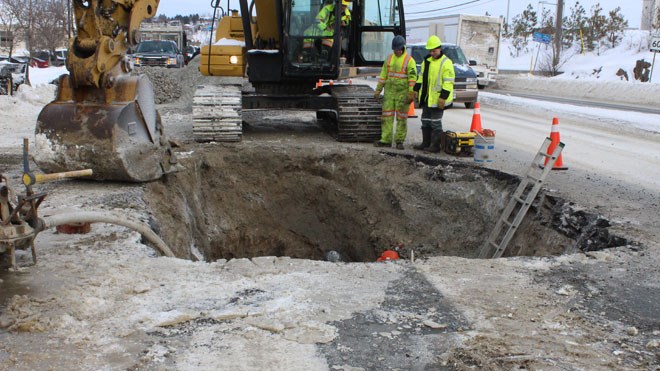Using a contract to repair water mains in the city as an example, he said the winning bidder in 2005 estimated the value of the contract to be $247,437 a year. That was based on an estimate of the number of repairs that would be required each year, with a set price for each repair. It was a three-year contract, and the city exercised an option to extend it for another two years.
However, the number of repairs spiked over the five years, meaning the average spent each year was $1.6 million, for a total of almost $8.1 million.
When the contract was tendered again in 2011, Bigger said the firm already doing the work knew the value of the contract would likely be much higher than the estimate, giving it an inside advantage over other bidders.*
“Generally, the higher the volume of work that is estimated, the more competitive the rates a bidder will be willing to offer,” Bigger said. “It is possible that another competitor could have provided even more competitive rates had they known the true value of the total dollar spend under the contract.”
The firm was awarded the contact again in 2011, estimating the cost at $740,000 a year. But actual value in the last three years has been $2.8M a year, as the city's rapidly crumbling water and sewer infrastructure springs more leaks.
Staff should have done a better job in estimating the true value of the contract, Bigger said.
“The concern here is related to the competitive procurement process,” he said. “Only by disclosing the full value of a contract would the city be able to ensure that it is obtaining best value and it is not clear that this goal has been met.”
However, city managers said the contract was issued knowing the number of breaks was likely to increase. That's why, in 2005, the city began using contractors for emergency repairs, since the cost of having city staff working overtime hours to repair breaks in the middle of the night would have been far higher.
Lorella Hayes, the city's chief financial officer, said the contract was designed to ensure the city could react quickly to emergency breaks, and the unit price gave them cost certainty regardless of how many breaks there were.
In the 2005 contract, they estimated there would be 60 breaks a year; in the 2011 contract, they estimated 190. Unlike the auditor, she said they didn't have hindsight to rely on, and so had to make their best guess based on previous years.
“We used the best (historical) information at hand to estimate volume in those contracts,” she said.
The current contract has allowed the city to respond to a soaring number of water main breaks quickly, she said, without taking staff away from planned maintenance and other work, which would cause even more problems in the long run.
Tony Cecutti, the city's general manager of infrastructure, said the contract also gives them the flexibility to plan emergency repairs during off-peak hours, without increasing the cost of the repair. That's especially important when the affected roads are key arteries.
“It's not uncommon for us to delay a repair on The Kingsway until after 5 p.m. and everyone has gone home,” he said.
In fact, the system Greater Sudbury uses is so efficient in dealing with emergency breaks, other municipalities have sent staffers here to study how it works, Cecutti said.
While the estimates of how many emergency breaks have been off, he said that's a result of the poor state of the city's water infrastructure, which is reflected in the skyrocketing number of emergency breaks.
“We're struggling to estimate how often the breaks will occur,” he said. “Nobody could have predicated accurately the changes in volume.”
He compared it to the winter snowplowing budget, which rises or declines, according to the weather. So how often the city uses contractors depends on factors beyond their control.
“Changes in quantities often change in the course of a contract.”
But Bigger said that was beside the point. He argued that if all contractors knew the potential dollar value of the contract in 2011, it may have attracted more bids.
He recommended tendering the contract again at the end of 2014, rather than picking up the options for another two years.
“When you have contractors doing nine times the volume of the estimate … there seems to be a need to re-evaluate the value of this contract,” he said. “We believe there is a significant opportunity here for the city.”
But Cecutti said the contracts are negotiated according to a set unit price, which protects taxpayers when there is a big increase in the number of repairs. Management also recently negotiated an agreement with its unionized staff to take on more of the emergency repair work, he said, without charging the city normal overtime rates.
“We're learning now how well it's working,” Cecutti said, recommending that the contract should be extended for the last two years. “As long as we believe the unit price represents good value for the taxpayers, we will recommend continuing with the contract.
“We feel very strongly the last tender was very valid. All bidders had the same information.”
*An earlier online version of this story incorrectly stated there was only one bidder for the 2011 water main repair contract. In fact there were three bidders. Northern Life apologizes for the error.
